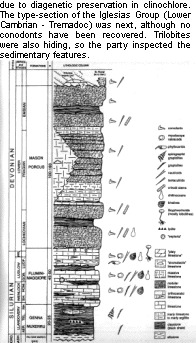|
|
Ichthyolith IssuesSpecial Publication 5
resulted [more in Issue 21 and see web site]
IGCP 406 ~ 2000
Meetingsfor 2000, the final year of the
project, include a workshop in association
with the Early Vertebrates meeting in
Flagstaff, Arizona, together with field
excursions to the southwestern USA, and the
final Annual Meeting to be held in Syktyvkar,
Russia, which will include a field excursion to
the Ordovician through Carboniferous of the
subpolar Urals (see web site).
*************************
IGCP 421 & ECOS VII: Pre-
symposium field trip (and cultural
delights) - Sardinia 20-22 June
1998
29 workers from 10 countries attended this
trip. They set off with their newly acquired
ECOS VII rucksacks to the first locality, in
the Upper Ordovician of Cea Brabetza, near
San Basilio, which was some way up a small
track; minibuses were used lest the conodont
workers should have to walk too far in the
Sardinian sunshine. Detailed explanation of
the geology and conodonts of the roadside
outcrop was given by Annalisa Ferretti, Enrico
Serpagli, Francesco Leone and Alfredo Loi
(with occasional translation by Gian Luigi
Pillola).
We walked to Locality 2 in Silurian
rocks 500m east of Silius Village, using a
field path that had been generouslycleared
by the local farmers. Sample bags and
hammers at the ready, we listened as Enrico,
Carlo Corradini and Annalisa describe geology
and conodonts with the aid of some finely
crafted posters. Samples were taken, and
sunblock applied as the sun rose further into
the cloudless sky.
Staying in the Silurian Ockerkalk, the
next locality featured nodular limestone with
loboliths. Lunch followed in a small farmhouse
where we were greeted by the (soon to
become familiar) smell of barbecued sucking
pig - the vegetarians among us found this a
trifle difficult to cope with, even the
omnivorous Chief Panderer Dick Aldridge.
A slight leap up the stratigraphic
column took us to the Upper Devonian
(Famennian) near Villasalto village where two
sections were examined. Carlo and Gian Luigi
provided yet another superb explanation of
the geology before we embarked on possibly
the most strenuous walk of the day, which
actually involved a slight incline. People
marvelled at the climbing expertise of the
younger Repetski (Rocco, age 12). After a
wonderful first day we sat on the terrace
sipping drinks kindly bought by the Mayor of
Villasalto.
Day two began in the Cambrian Cabitza
Formation of southwest Sardinia, where the
conodont faunas have been completely
remineralised to a fetching shade of green
|
|
|
|

|
|
|
|
|
|
Section from Sardinian fieldguide
Near Fluminimaggiore small, but
attractive, exposures of Orthoceras
Limestone (Wenlock-Ludlow) impressed
everyone with the macrofossils (nautiloids,
graptolites and bivalves). Once again, the
quality of posters used to aid description of
the outcrop and a further repast of
gargantuan proportions, accompanied by
plenty of wine and water, fulfilled us.
The last geological stop was a Lower
Devonian section near Fluminimaggiore. The
14m outcrop of limestones and mudstones
contains an abundant conodont fauna and a
variety of macrofossils from the Mason
Porcus Formation (deltaZone). Samples were
enthusiastically collected before return to the
bus, where Gian Luigi and Alfredo provided an
impromptu water flinging entertainment in a
horse trough.
It is not possible to visit Sardinia and
concentrate solely on geological aspects, so
a deviation into archaeology concluded the
day. The Nuraghe settlement dating back to
between the XIII and IX centuries BC
consisted of a large central cone-shaped
tower, surrounded by, and connected to, five
smaller towers around which a town was built.
Barry Fordham posed a pertinent question on
the subject of the symbolic statues and the
relevance of the number of breasts these
possess. The answer is, for those of you who
are interested, that most female statues have
|
|


 1
2
3
4
5
6
7
8
9
10
11
12
13
14
15
16
17
18
19
20
21
22
23
24
25
26
27
28
29
30
31
32
33
34
35
36
37
38
39
40
41
42
43
44
45
46
47
48
1
2
3
4
5
6
7
8
9
10
11
12
13
14
15
16
17
18
19
20
21
22
23
24
25
26
27
28
29
30
31
32
33
34
35
36
37
38
39
40
41
42
43
44
45
46
47
48



 1
2
3
4
5
6
7
8
9
10
11
12
13
14
15
16
17
18
19
20
21
22
23
24
25
26
27
28
29
30
31
32
33
34
35
36
37
38
39
40
41
42
43
44
45
46
47
48
1
2
3
4
5
6
7
8
9
10
11
12
13
14
15
16
17
18
19
20
21
22
23
24
25
26
27
28
29
30
31
32
33
34
35
36
37
38
39
40
41
42
43
44
45
46
47
48

